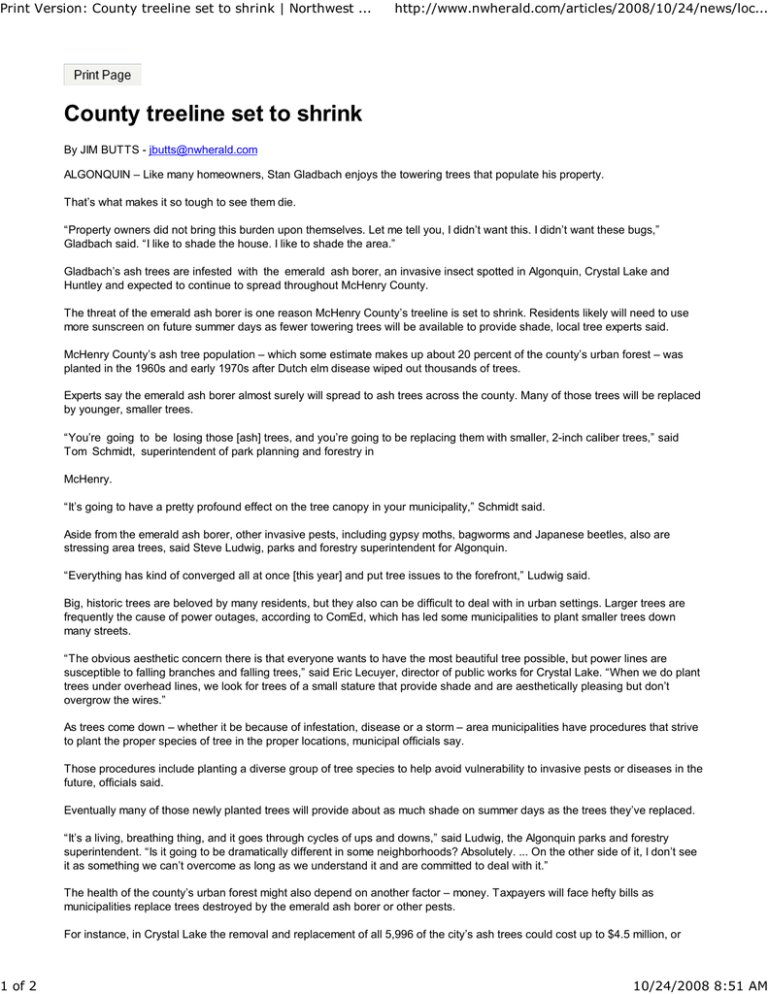Print Version: County treeline set to shrink | Northwest ...
advertisement

Print Version: County treeline set to shrink | Northwest ... 1 of 2 http://www.nwherald.com/articles/2008/10/24/news/loc... County treeline set to shrink By JIM BUTTS - jbutts@nwherald.com ALGONQUIN – Like many homeowners, Stan Gladbach enjoys the towering trees that populate his property. That’s what makes it so tough to see them die. “Property owners did not bring this burden upon themselves. Let me tell you, I didn’t want this. I didn’t want these bugs,” Gladbach said. “I like to shade the house. I like to shade the area.” Gladbach’s ash trees are infested with the emerald ash borer, an invasive insect spotted in Algonquin, Crystal Lake and Huntley and expected to continue to spread throughout McHenry County. The threat of the emerald ash borer is one reason McHenry County’s treeline is set to shrink. Residents likely will need to use more sunscreen on future summer days as fewer towering trees will be available to provide shade, local tree experts said. McHenry County’s ash tree population – which some estimate makes up about 20 percent of the county’s urban forest – was planted in the 1960s and early 1970s after Dutch elm disease wiped out thousands of trees. Experts say the emerald ash borer almost surely will spread to ash trees across the county. Many of those trees will be replaced by younger, smaller trees. “You’re going to be losing those [ash] trees, and you’re going to be replacing them with smaller, 2-inch caliber trees,” said Tom Schmidt, superintendent of park planning and forestry in McHenry. “It’s going to have a pretty profound effect on the tree canopy in your municipality,” Schmidt said. Aside from the emerald ash borer, other invasive pests, including gypsy moths, bagworms and Japanese beetles, also are stressing area trees, said Steve Ludwig, parks and forestry superintendent for Algonquin. “Everything has kind of converged all at once [this year] and put tree issues to the forefront,” Ludwig said. Big, historic trees are beloved by many residents, but they also can be difficult to deal with in urban settings. Larger trees are frequently the cause of power outages, according to ComEd, which has led some municipalities to plant smaller trees down many streets. “The obvious aesthetic concern there is that everyone wants to have the most beautiful tree possible, but power lines are susceptible to falling branches and falling trees,” said Eric Lecuyer, director of public works for Crystal Lake. “When we do plant trees under overhead lines, we look for trees of a small stature that provide shade and are aesthetically pleasing but don’t overgrow the wires.” As trees come down – whether it be because of infestation, disease or a storm – area municipalities have procedures that strive to plant the proper species of tree in the proper locations, municipal officials say. Those procedures include planting a diverse group of tree species to help avoid vulnerability to invasive pests or diseases in the future, officials said. Eventually many of those newly planted trees will provide about as much shade on summer days as the trees they’ve replaced. “It’s a living, breathing thing, and it goes through cycles of ups and downs,” said Ludwig, the Algonquin parks and forestry superintendent. “Is it going to be dramatically different in some neighborhoods? Absolutely. ... On the other side of it, I don’t see it as something we can’t overcome as long as we understand it and are committed to deal with it.” The health of the county’s urban forest might also depend on another factor – money. Taxpayers will face hefty bills as municipalities replace trees destroyed by the emerald ash borer or other pests. For instance, in Crystal Lake the removal and replacement of all 5,996 of the city’s ash trees could cost up to $4.5 million, or 10/24/2008 8:51 AM Print Version: County treeline set to shrink | Northwest ... 2 of 2 http://www.nwherald.com/articles/2008/10/24/news/loc... about $750 a tree, according to the city’s response plan. Those figures are based on the worst-case scenario that all ash trees are killed in three to five years, according to Crystal Lake’s plan. With the recent downturn in the economy, it’s debatable how apt city leaders will be to support tree planting in the face of tightening budgets. A lot will depend on how quickly the emerald ash borer spreads through area communities, municipal officials say. In Algonquin, Ludwig knows village leaders will face tough decisions. “When I’m arguing money against police cars and ambulances, there’s a logical hierarchical order that makes sense,” he said. “I’m hopeful but not unrealistic.” Residents such as Gladbach will face similar decisions in coming years. In Gladbach’s case, he has worked with an arborist to either treat or safely dispose of the ash trees on his property. “I don’t want to add to the problem,” he said. He’s also already working to plug the holes left by some of the towering ash trees, but it might take a while. “I’ve got some oaks that some squirrels planted for me, and I transplanted those. They’re doing really well,” he said. “You do the best you can.” Copyright © 2008 Northwest Herald. All rights reserved. 10/24/2008 8:51 AM







